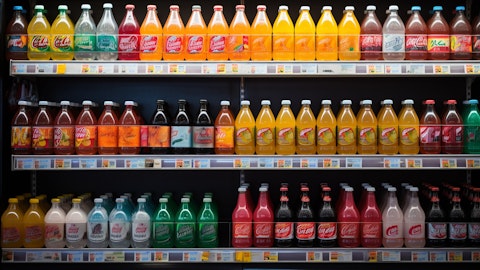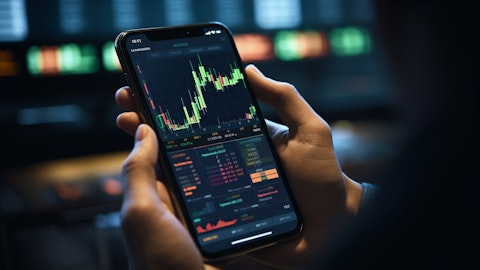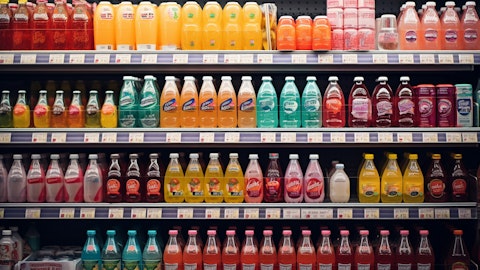Hilton Schlosberg: No, the only structural reason is we don’t give guidance. So that’s the only structural reason I can think of. Obviously, we’re working on margins. I’m proud to say that the Midwest premium and aluminum, which is one of [indiscernible] are coming down. But against that, we’ve said that we have increases in other commodities and other pricing. So we’re bringing up our own manufacturing facilities up and we’re doing whatever we can to improve gross profit percentages. But we don’t give guidance and I don’t know what’s going to happen with freight, for example. We had a good benefit from freight-in this quarter — this last quarter, and I’m not sure what’s going to happen as we look forward into 2024 and the implications of the election and everything else.
So that’s about that. And then on pricing, we’re taking pricing in a number of markets internationally. We’ve taken pricing in January in a number of markets. And we’re moving through with an aggressive price increase program internationally. As regards to the U.S., we really are just — we’re waiting and evaluating. We run a very sizable business here. We have a number of customers that we deal with. And we want to make the right decision. So we’re not saying no to a price increase, and we’re not saying yes to a price increase this time. What we are saying is that we are honestly really evaluating and constantly evaluating the retail pricing environment. And if we believe there are opportunities, we will take them.
Operator: The next question is from Dara Mohsenian from Morgan Stanley. Please go ahead.
Dara Mohsenian: Hi, guys. Good afternoon. So the comments on some of the U.S. performance were helpful. Just given the strength of that global January number, can you spend some time discussing what you’re seeing internationally in terms of category growth and your market share progression? And any thoughts on maybe key expansion plans internationally in terms of some of your key brands and how we should think about that for 2024? Thanks.
Hilton Schlosberg: So, Dara, on the call, we did talk about progress internationally in very great detail. I think sometimes we give far more detail than we should, but we do. We gave market shares in various countries we indicated the new product innovations that are going to happen through — throughout our international territories, and I’m not sure what other question — what part of your question, we possibly have an answer. And I don’t mean to be disrespectful. I just feel that a lot of your question has been covered. Rodney, I don’t know if you’ve got anything to add.
Rodney Sacks: No. Other than the — there’s — if you look at the international markets, they’ve sort of been a little bit all over the place in many ways. But generally, they’ve been good. There was a little bit of slowing in Asia Pacific. We are taking steps to see some growth. But obviously, we are very substantial in those markets and the actual markets have been a little flatter. But we’ve got great opportunity in some of the international markets that are developing. We look particularly to markets like China and India. We’re at the beginning of a growth phase in India, particularly focusing on not only Monster, but also Predator there. So I think that it is mixed. Some of the markets have had some sort of ups and downs, but overall, we’re in growth in most of the markets, and we still see that as very exciting. And you can see from the results in January, we are still seeing — despite the Nielsen numbers, we are still seeing good growth in the U.S. as well.
Operator: The next question is from Steve Powers with Deutsche Bank. Please go ahead.
Steve Powers: Yes. Hey, good afternoon, guys. Two questions for me, if I could. The first one is just on G&A expenses in the quarter. They were up a lot relative to our expectations of almost 25% in the fourth quarter. Just anything to unpack there and anything anomalous in that number?
Hilton Schlosberg: Yes, we spoke about — Steve, sorry to interrupt, but let’s just answer the first. So remember, we spoke about impairment charges of $40 million in this quarter relating to the Alcohol Brands.
Steve Powers: Yes. Sorry, I’m excluding that. It’s still up a lot, excluding the impairment charges.
Hilton Schlosberg: We’ll look at that, but it’s not what I’ve been seeing.
Steve Powers: Okay. The second question is, in January, you highlighted plans just to step up focus on in-market execution in the U.S., specifically commercialization around placing of the full portfolio and innovation. And just any update you can share on progress made and cooperation you’re getting on the — from the Coke system on that effort?
Hilton Schlosberg: Yes. I think that’s not a one-fix issue. That’s something that’s ongoing, and we are working with the Coke bottlers to improve execution. As I said earlier, we are rolling out a number of new products and the new sets are all taking place in this first quarter from February onwards and early into the second quarter. And I think you’ll see that — well, I hope you’ll see from those numbers when we report them, that the positioning should be somewhat different to where we are today.
Operator: The next question is from Mark Astrachan with Stifel. Please go ahead.
Mark Astrachan: Yes. Hey, afternoon guys. I wanted to go back to international because I feel like it’s one of those things that doesn’t get the credit that’s due, right? You built nearly a $3 billion run rate business at this point. And I think from the outside, it’s a little bit hard to get a sense of kind of what’s going on there. So not necessarily to Dara’s question, but maybe talk to some of the dynamics in terms of number of SKUs that you have on shelf, not obviously by country, but sort of broader strokes of the opportunity you have to still develop your portfolio within those markets? How much opportunity is there broadly to develop the energy category? And sort of related to that, margins have improved, but they’re obviously still a lot lower than your domestic margins, both gross margin and EBIT margin in that international business.
How do you think about improving that over time? Is that possible relative to current levels? And kind of how do you think about the progression of that?





